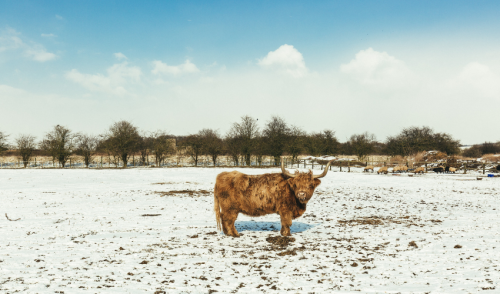{article.name}
Winter Cow Care

- Share this:
- Share on Facebook
- Pin on Pinterest
- Tweet on Twitter
Cows can easily adapt to different seasons, but they can still suffer during the harshest winter months, losing condition and becoming less productive. By practicing good winter cow care, however, you can protect your herd from the dangers of the season and ensure they reach spring in top form.
8 Steps to Care for Your Cows in Winter
No matter what size herd you have, whether you have a large commercial herd or just a few cows for your family’s use, they still need good care to thrive in winter. That care should start long before winter sets in, and you need to remain diligent throughout the season to keep your cows safe, healthy, and protected from the worst of winter weather.
- Fall Checkups Before winter begins, assess your herd’s health and condition with an autumn veterinary checkup. Deworm and delouse your cows if necessary, and be sure vaccinations are properly updated. This is a good time to catch any potential problems early, before the stresses of winter can take their toll. You may also want to consider selling or butchering cows that may continue to decline over the winter, making the most of them in the fall before they lose condition any further, and conserving resources for the rest of the herd.
- Change to a Winter Diet While cows will continue to forage throughout the winter, the condition of the pasture will degrade and they will need supplemental feed and extra hay to consume enough calories to stay warm in the coldest weather. Nutrient-dense, higher protein feed is a good option, and consider mineral supplements to ensure a balanced, healthy diet. Feeding cattle later on winter days can also help keep them warmer through the coldest part of the night, since the body heat generated by rumen digestion peaks several hours after eating.
- Keep Water Liquid Cows can and will eat snow and ice to meet their moisture needs in the winter, but doing so can lower their body temperature dramatically. If you keep liquid water available to your cattle, not only will they be sure to get enough to drink, but they won’t need as much feed to maintain adequate body temperatures. Use tank heaters to keep water sources from freezing, or carefully monitor natural watering holes to keep them accessible even in the chilliest weather.
- Provide Sturdy Shelter Cows’ coats will naturally thicken in late fall and their own body fat provides natural insulation, but strong winds, heavy snows, and freezing rain can drastically impact your herd if no shelter is available. Provide a three-sided, covered windbreak that cows can easily access, and plant natural wind barriers such as evergreen trees alongside your pasture to provide easy, convenient shelter. Be sure the sheltered areas are large enough to accommodate all your cows without crowding that can lead to behavioral problems or leaving any animals out in the cold.
- Deepen Bedding When cows lay down, they fold their front legs under their bodies, but their back legs are more exposed. Laying on cold ground can also chill their bodies more quickly, requiring extra food and higher calorie intake to maintain body temperature. By providing deeper bedding, the cows will be more insulated and less susceptible to this type of chilling. Be sure the bedding is clean and dry, however, or else it may cause additional problems.
- Minimize Mud A damp, muddy pasture is dangerous for your cows in several ways. Uncertain footing can lead to more slips and trips that can create foot and joint injuries, and mud can harbor viruses, fungus, and bacteria that can lead to thrush, foot rot, and other unpleasant and dangerous conditions. The dampness on the ground is also chillier for any cattle that lay down. To minimize mud, put down a thick layer of wood chips or gravel for better winter drainage in wet areas.
- Provide Extra Care for Calves Calves are exceptionally vulnerable in the winter, and are not able to regulate their body temperature easily. Using calf jackets or individual calf hutches on the coldest nights can provide extra protection for these youngsters, and you should also carefully monitor milk production to be sure young calves are nursing well and there are no udder problems such as chapping, scratches, or other injuries that can hurt nursing cows.
- Watch Carefully Above all, watch your winter herd carefully. Be observant for changes in behavior, feeding rhythm, food preferences, body condition, coat quality, water consumption, and energy and be alert for any potential problems. The sooner difficulties are noticed, the easier it will be to provide the best care possible to help your cows overcome any challenges that winter brings.
Winter can be a tough season even for the hardiest cows, but with the proper care, they will thrive through the season and be in top condition when spring arrives.
Special Offers
We are constantly adding new specials to our site. Be sure to check back often!



Comments